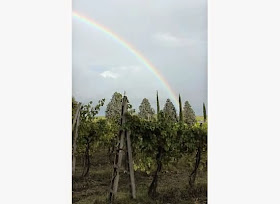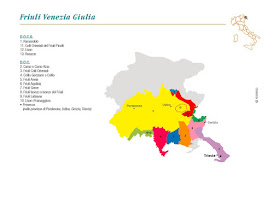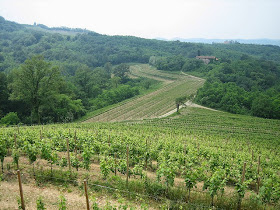 |
| San Gimignano, Tuscany |
 Throughout all the grapes of Italy,
Vernaccia di San Gimignano was the first to be granted DOC status in
1966 and later was granted DOCG status in 1993. About 5 months back
I wrote a blog on the 2012
Crete Rosse Chianti D.O.C.G. that the Tenuta Torciano winery
from San Gimignano had shared with me. Today I'm sharing with you
their 2012 Poggio Aicieli Vernaccia di San Gimignano.
Throughout all the grapes of Italy,
Vernaccia di San Gimignano was the first to be granted DOC status in
1966 and later was granted DOCG status in 1993. About 5 months back
I wrote a blog on the 2012
Crete Rosse Chianti D.O.C.G. that the Tenuta Torciano winery
from San Gimignano had shared with me. Today I'm sharing with you
their 2012 Poggio Aicieli Vernaccia di San Gimignano. I looked forward to this sample as I am a fan of Vernaccia. I thought this wine was a great expression of the vernaccia grape. This is a grape that you will be able to locate in many wine shops as it's not as discreet as some of the other grapes. Tenuta Torciano also has some great wine clubs that you can enjoy as well that shares with you 24 of their wines throughout the year including future discounts. The Poggio Aicieli, meaning “hills to the skies”, had a slight tropical bouquet with an almost clear color to it in the glass with a hint of straw coloring. Being a lighter, refreshing wine it was dry with mouthwatering acidity, nice minerality, some citrus and I picked up lots of sea saltiness on the finish.
I paired this wine with a couple dishes
over a couple days, both very different. One was a roasted chicken
with roasted potatoes and black olives along with a spinach salad
topped with goat cheese, cranberries, walnuts and a homemade
vinaigrette. I enjoyed at least half the glass by itself before
eating as it was the end of a nice summer day and no better way to
unwind than with a glass of wine. It paired nicely with the
chicken. My next meal was from Frances Mayes new cookbook “TheTuscan Sun Cookbook”. It was stuffed pasta, I used shells, with
ricotta and pears covered with a gorgonzola cream sauce and topped
with toasted walnuts. Delicious! It was nice how the creamy sauce
smoothed out the acidity of the wine and the fruit of the wine was
more present. Two different meals that both paired nicely in their
own way showcasing the wine slightly different. The fun of wine and
food pairing.
Pierluigi Giachi and his family are
backed by 14 generations of winemaking. They have an estate that
offers a wide variety of activities and a food and wine experience to
satisfy your desires. Check them out and seek out a Vernaccia this
summer!























